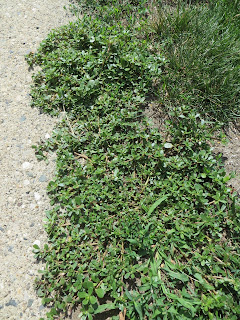 |
Common purslane is a weed of crevices between
bricks, in cracked cement, or compacted, low nutrient
soils. It also can be found in most cultivated crops,
gardens, lawns, and landscape beds (Photo: NMSU) |
Featured Diagnosis: Common purslane (Portulaca oleracea) is a summer annual with a prostrate, mat-forming growth habit and thick, succulent stems and leaves. The plant germinates from seed during the warmer summer months (from March until August) and is a troublesome weed in cultivated fields, gardens, and landscapes throughout New Mexico. It is easily identified by its’ smooth reddish or flesh colored stems along with leaves that are succulent, shiny, green with maroon tinges, almost teardrop shaped, and wider at the tip than at the base. In late summer, the plant produces bright yellow flowers that have five petals and are only open when it is sunny. The plant also produces large amounts of viable black seeds that are produced in fleshy capsules that resemble unopened flower buds. These seeds have the ability to remain viable in the soil for multiple years before germinating.
 |
Common purslane can be identified by it's smooth
reddish stems and shiny, succulent, teardrop-shaped
leaves (Photo: NMSU) |
 |
The bright yellow flowers of common purslane
are only open when sunny (Photo: NMSU) |
 |
Fleshy pods open at maturity to release multiple
tiny black seeds into the soil (Photo: NMSU) |





No comments:
Post a Comment